WORLD CLASS COACHING
Build Up From the Back - Exercises 1
By Luca Bertolini
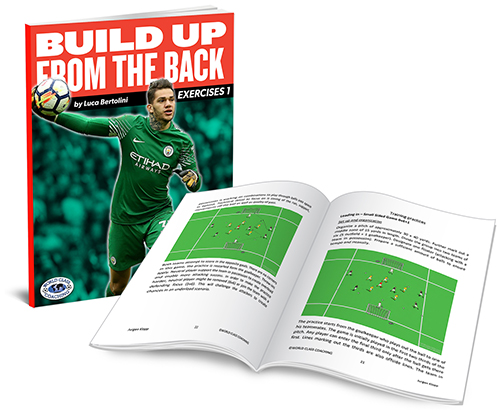
Table of Contents
PART ONE
Introduction
Goalkeeper Distribution
PART TWO
Distribution Along the Flanks
PART THREE
Switching Play From Flank to Flank
PART FOUR
The La Volpe Exit
Possession Rondos and Position Games
Introduction
This is the second volume of the building up from the back topic and the first of two about the exercises to coach this phase of play. This first book includes:
1) Technical exercises to coach the player technical skills, the individual tactics and the passing pattern of play to build up and to play out, breaking the first line of the opposition without active pressure (air-bodies are the opponents at this stage).
2) Rondos, possession and position games to work on the player tactical skills to build up and play out against active pressure and to coach the reactions to the loss or the recovery of the ball.
Tactical exercises, real game situations and specific small-sided games will be included in the second volume.
Positional play is necessary to build up play from the back because it allows forward passes from the first third, it creates numerical advantages in the middle third with a defender or the fullbacks pushing forward, or it creates 1 v 1 duels up front. To build up from the back means to have a goal in mind.
The concept of "build up" could also last until the final stage of the attacking phase, just before a player is able to face the opposition goal and create a scoring chance; for this reason it is very important to break up the general concept and to understand how to coach the specific game situation of the building up from the back and of the playing out phases.
Build up from the back means the goalkeeper is in possession of a still ball or the defenders are not under active pressure, and the move has to be started.
• The center backs are usually positioned wide
• The fullbacks must be placed on wide and advanced positions
• The middle third has to be overload to ensure numerical advantage
• The wingers must made the pitch as wide as possible
• The forwards can both stay placed high on the pitch or drop back to help the advanced midfielders
• The back four or three don't have to be placed on the same imaginary line to provide passing options for the ball carrier, enabling the creation of triangles among them; this idea should work between the couple of fullbacks, of the center backs, and among them collectively too
• The players should be able to receive with a proper body shape to play forward as the ball is received; the posture must be angled toward the following pass or dribble direction
• The midfielders should create space for the defenders to dribble up if there's no pressure, attacking the opposition defense line when defending deep
• It has to create numerical advantages to play forward or to keep the possession if it's not possible to go up the pitch. This is the point of the phase where a second division is necessary:
a) If the possession direction is directed backwards, then we have to talk about "build up to play out from the back,” as opposition pressure is supposed to be active (however strong or not)
b) If the possession direction is standing or it is directed forward, we then may talk about "to build up play during the possession phase"; this is the phase of play that should take the move to the final stage
Build up from the back

Build up to play out from the back

If the possession team must build up to play out from the back, that means the creation of a space in the middle third is not possible and the opposition pressure lines cannot be broken through.
The ball must be then play backwards, even through the goalkeeper, to move the opposition and to switch the side of play to try to go forward again.
Build up play during the possession phase

The building up of play means that the team in possession is trying to create a finishing chance wherever the ball is (inside the defense half or the attacking half).
Whatever the differences among these different phases of play, some common key points are:
1) Depth is more decisive than width if the team wants to play forward
2) All the players should take part in this phase to circulate the ball, to create space, numerical and positional advantages to attack the opposition half
3) Look for individual solutions in the middle third
4) Keep the pitch as big as possible
5) Escape the marker with the right timing to receive and with the correct body shape.
Goalkeeper distribution (all the passing patterns of play aim to coach the short distribution)
The goalkeeper must be able to play targeted passes as well as to receive back passes, to control them and even to play with one touch; another important key point is the technical skills with both the feet to help the play out from the back if the team is under pressure. He must be able to recognize the better positioned teammate, who can receive without opposition pressure.
Exercise 1: distribution with center backs and a forward teammate against two opponents

Set-up and Sequence: one goalkeeper and three players are placed inside a rectangular or square area; two air-bodies are placed in the middle to simulate two opponents. The goalkeeper is in possession and when he sends a sign, the center backs run wide to receive; the sequence starts from the right in the picture. As the first center back receives, the forward balance player must be unmarked at the back of the air-body; he receives and passes back to the goalkeeper, who carries on the sequence on the other side, and the balance player must be unmarked at the back of the opposite air-body to pass back again.
The players rotate their positions clockwise or counterclockwise.
Variation: the goalkeeper can decide the side where to start the sequence time to time.
Eye on: play diagonal passes, be unmarked behind the air-body and pay attention to the timing of runs and passes.
Exercise 2: distribution with center backs and a forward teammate against two opponents
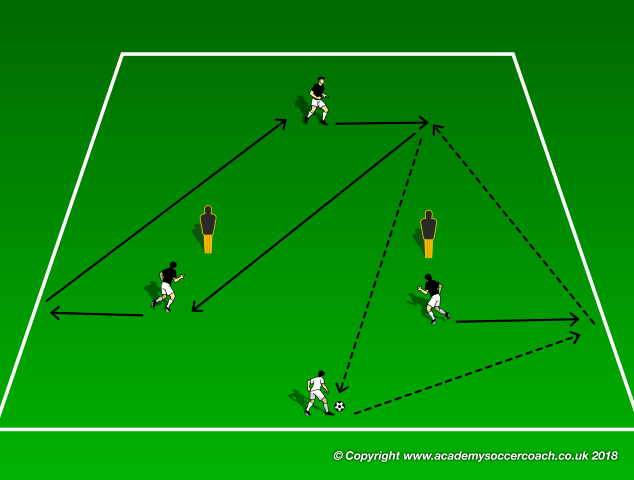
Set-up and Sequence: this is a variation of the previous practice. The goalkeeper is in possession and when he sends a sign, the center backs run wide to receive; one center back receives and the forward balance player must be unmarked at the back of the air-body; he receives and passes back to the goalkeeper. The center back who didn't receive the ball must exchange the position with the balance player after the back pass.
Eye on: play diagonal passes, be unmarked behind the air-body, pay attention to the timing of run and passes and reaction speed to receive and pass or to move without the ball.
Exercise 3: distribution with center backs and a forward teammate against two opponents
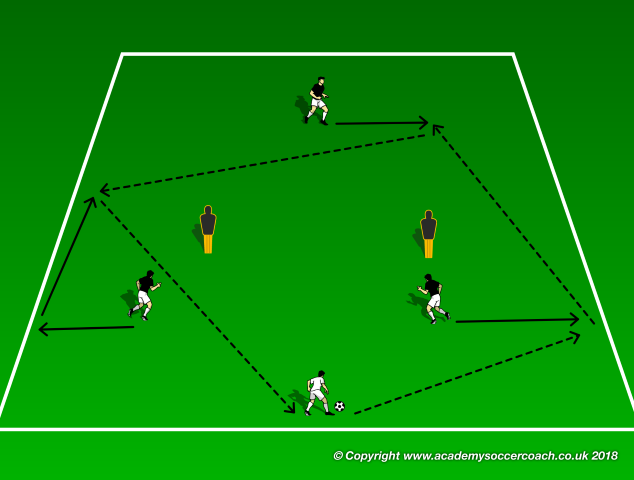
Set-up and Sequence: one goalkeeper and three players are placed inside a rectangular or square area; two air-bodies are placed in the middle to simulate two opponents. The goalkeeper is in possession and when he sends a sign, the center backs run wide to receive; the sequence starts from the right in the picture. As the first center back receives, the forward balance player must be unmarked at the back of the air-body; he receives and passes toward the opposite side where the other center back is unmarked sideways of the air-body. The sequence goes on with the back pass toward the goalkeeper.
The players rotate their positions clockwise or counterclockwise.
Variation: the goalkeeper can decide the side where to start the sequence time to time.
Eye on: play diagonal passes, be unmarked behind and sideways the air-body and pay attention to the timing of run and passes.
Exercise 4: distribution with center backs and a forward teammate against two opponents
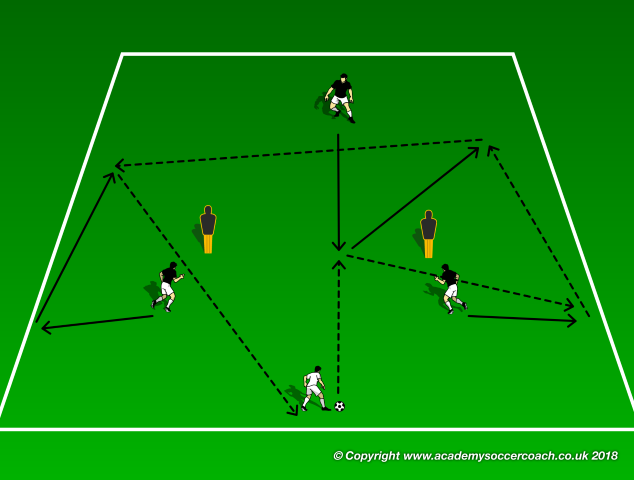
Set-up and Sequence: this is a variation of the previous practice. The goalkeeper is in possession and when he sends a sign, the center backs run wide to receive. The sequence starts with the center balance player who drops back in between the air-bodies to receive the first pass. He then passes the ball toward one center back (on the right in the picture) who receives and sends a return pass behind the air-body. The balance player passes then toward the opposite side where the other center back is unmarked sideways of the air-body. The sequence goes on with a back pass toward the goalkeeper.
The players rotate their positions clockwise or counterclockwise.
Variation: the goalkeeper can decide the side where to start the sequence time to time.
Eye on: play vertical and diagonal passes, be unmarked behind and side-on to the air-body, pay attention to the dropping back timing, behind and sideways runs and passes.
Exercise 5: distribution with center backs and a forward teammate against two opponents
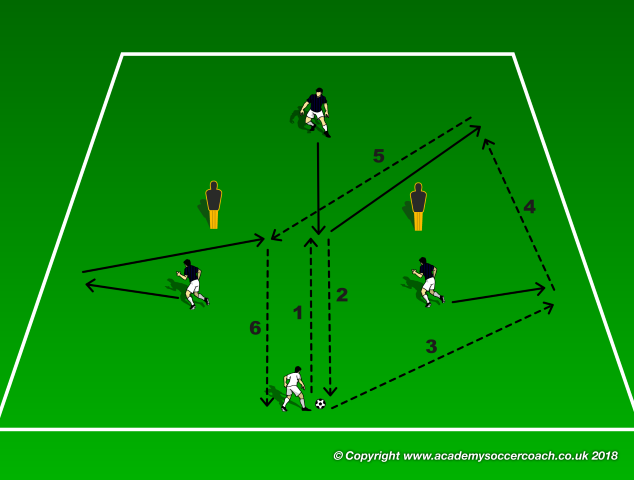
Set-up and Sequence: one goalkeeper and three players are placed inside a rectangular or square area; two air-bodies are placed in the middle to simulate two opponents. The goalkeeper is in possession and when he sends a sign, the center backs run wide to receive. The sequence starts with the center balance player who drops back in between the air-bodies to play a wall pass with the goalkeeper. The goalkeeper passes out wide to the center back (on the right in the picture), who receives and he passes forward and behind the air-body, where the center balance player receives. The opposite center back runs inside in front of the nearest air-body to receive and to pass back toward the goalkeeper.
The players rotate their positions clockwise or counterclockwise.
Variation: the goalkeeper can decide the side where to start the sequence after the first wall pass time to time.
Eye on: play vertical and diagonal passes, be unmarked behind and in front of the air-body, pay attention to the timing of runs and passes, receive inside a back pass to play out again and cover the goal space.
Exercise 6: distribution with center backs and a forward teammate against two opponents
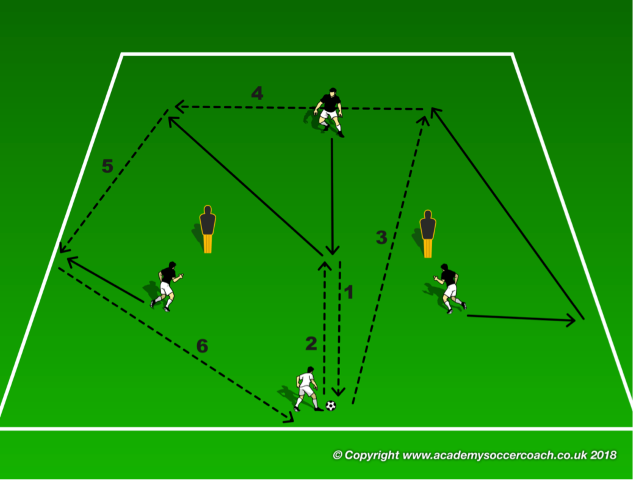
Set-up and Sequence: one goalkeeper and three players are placed inside a rectangular or square area; two air-bodies are placed in the middle to simulate two opponents. The goalkeeper is in possession and when he sends a sign, the first center back runs wide to receive; the sequence starts with the center balance player, who drops back in between the air-bodies to play a wall pass with the goalkeeper. The goalkeeper passes forward to the center back (on the right here), who receives behind the air-body and he changes the side of play for the balance player who moved back to be free away from the air-body. The opposite center back moved wide and sideways the air-body to receive and to pass back toward the goalkeeper.
The players rotate their positions clockwise or counterclockwise.
Variation: the goalkeeper can decide the side where to start the sequence after the first wall pass time to time.
Eye on: play vertical and diagonal passes, be unmarked behind and side-on to the air-body, pay attention to the timing of runs and passes, push forward to play out.
Exercise 7: distribution with center backs and a forward teammate against three (1-2) opponents
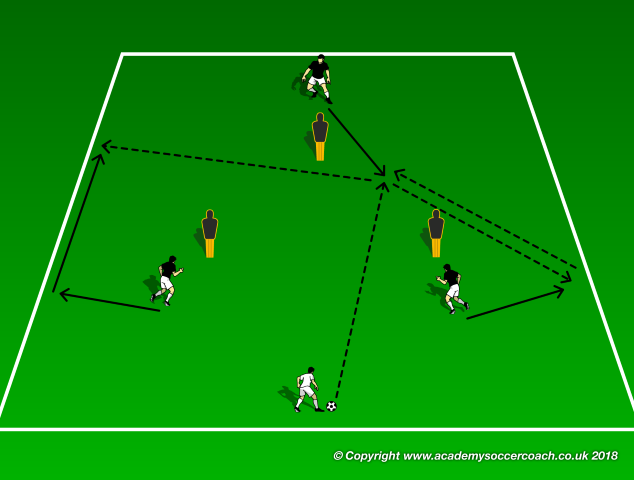
Set-up and Sequence: one goalkeeper and three players are placed inside a rectangular or square area; three air-bodies are placed in the middle to simulate two forwards and an advanced player. The goalkeeper is in possession and when he sends a sign, the center backs run wide; the sequence starts from the right in the picture. The forward balance player must be unmarked in front of the first air-body, dropping a little back; he receives and plays a wall passing combination with the first center back, who must be placed sideways and away from the air-body. As the back pass is received, he changes side of play toward the other center back who moved up, leaving the last air-body at the back.
The sequence goes on with:
• back pass toward the goalkeeper
• back pass toward the balance player who then pass again to the goalkeeper.
The players rotate their positions clockwise or counterclockwise.
Variation: the balance player can decide the side where to start the sequence time to time.
Eye on: play diagonal passes, be unmarked behind the air-body, pay attention to the timing of runs and passes.
Exercise 8: distribution with center backs and a forward teammate against three (1-2) opponents

Set-up and Sequence: this is a variation of the previous practice. The goalkeeper is in possession and when he sends a sign, the center backs run wide; the sequence starts from the right in the picture. The forward balance player must be unmarked behind and away from the first air-body; he receives and plays a wall passing combination with the first center back who must be placed sideways and away from the second air-body. As the back pass is received, the balance player changes side of play toward the other center back, who moved away and sideways the last air-body. The sequence goes on with a back pass toward the goalkeeper.
The players rotate their positions clockwise or counterclockwise.
Variation: the balance player can decide the side where to start the sequence, moving away from the first air-body on the left or on the right.
Eye on: play diagonal passes, be unmarked behind and sideways the air-body and pay attention to the timing of runs and passes.
Exercise 9: distribution with center backs and a forward teammate against three (1-2) opponents
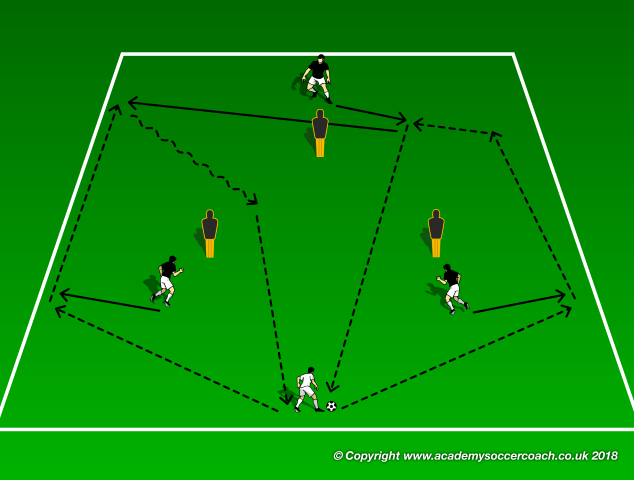
Set-up and Sequence: one goalkeeper and three players are placed inside a rectangular or square area; three air-bodies are placed in the middle to simulate two forwards and an advanced player. The goalkeeper is in possession and when he sends a sign, the center backs run wide; the sequence starts from the right in the picture. The forward balance player must be unmarked in front of the first air-body, dropping a little back; he receives and plays a wall passing combination with the first center back, who must be placed sideways and away from the air-body. As the back pass is received, he changes side of play toward the other center back who moved up, leaving the last air-body at the back.
The sequence goes on with:
• back pass toward the goalkeeper
• back pass toward the balance player, who then passes again to the goalkeeper.
The players rotate their positions clockwise or counterclockwise.
Variation: the balance player can decide the side where to start the sequence time to time.
Eye on: play diagonal passes, be unmarked behind the air-body and pay attention to the timing of runs and passes.
Exercise 10: distribution with center backs and a forward teammate against three (1-2) opponents
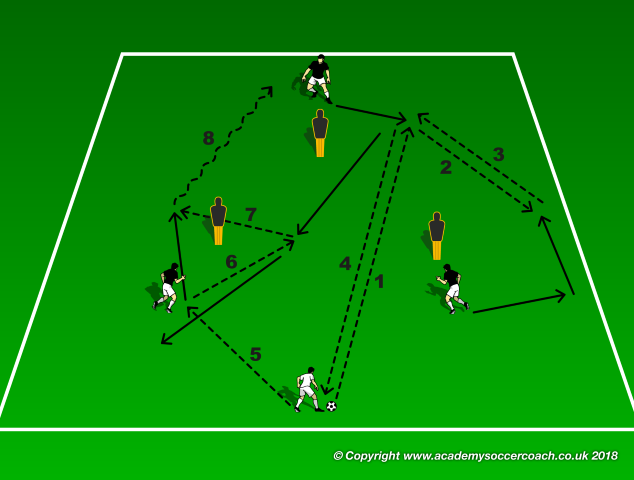
Set-up and Sequence: one goalkeeper and three players are placed inside a rectangular or square area; three air-bodies are placed in the middle to simulate two forwards and an advanced player. The goalkeeper is in possession and when he sends a sign, one center back runs wide; the sequence starts from the right in the picture. The forward balance player must be unmarked behind and away from the first air-body; he receives and plays a wall passing combination with the first center back, who must be placed sideways and away from the second air-body. As the back pass is received, the balance player passes back to the goalkeeper, who distributes again to play out toward other center back. The sequence goes on with a wall passing combination between the center back and the balanced player, who dropped back and the center back dribbles up to simulate the break through of the first pressure line. The sequence can end with a back pass to the goalkeeper.
The players rotate their positions clockwise or counterclockwise.
Variation: the balance player can decide the side where to start the sequence, moving away from the first air-body on the left or on the right.
Eye on: play diagonal passes, be unmarked behind and sideways the air-body, pay attention to the timing of runs and passes, and work on different lines.
Exercise 11: distribution with center backs and a forward teammate against three opponents
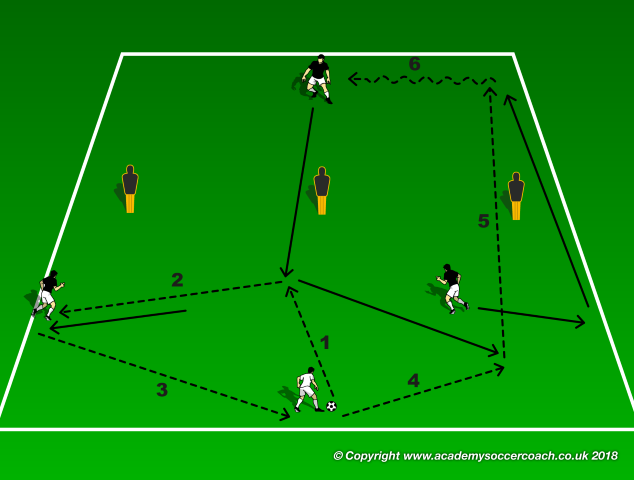
Set-up and Sequence: one goalkeeper and three players are placed inside a rectangular or square area; three air-bodies are placed in the middle to simulate three forwards on the same line. The goalkeeper is in possession and when he sends a sign, the center backs run wide; the sequence starts from the left in the picture. The forward balance player must drop back, anticipating the first air-body; he receives and plays a wide pass toward the first center back. The center back passes the ball toward the goalkeeper, who distributes toward the right side, where the balance player dropped off again on the same line of the defenders. The sequence goes on with a forward pass to the center back, who moved wide first and then behind the air-body, to simulate the break through of the first pressure line. The sequence ends dribbling the ball toward the center space and passing back to the goalkeeper.
The players rotate their positions clockwise or counterclockwise.
Variation: the balance player can decide the side where to start the sequence, dropping back on the left or on the right of the center air body.
Eye on: play vertical and diagonal passes, be unmarked away and behind the air-body, and pay attention to the timing of runs and passes, work on different lines.
Exercise 12: distribution with center backs and a forward teammate against three opponents
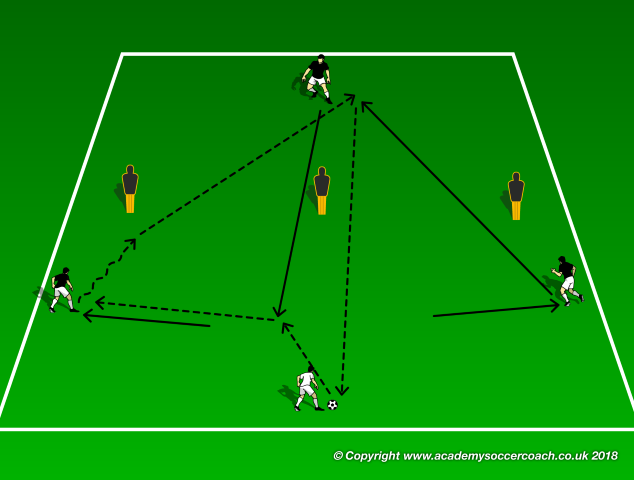
Set-up and Sequence: one goalkeeper and three players are placed inside a rectangular or square area; three air-bodies are placed in the middle to simulate three forwards on the same line. The goalkeeper is in possession and when he sends a sign, the center backs run wide and the forward balance player must drop back, anticipating the first air-body; he receives and plays a wide pass toward the first center back who dribbles the ball up, on the left in the picture. The second center back must cut inside and receive the ball behind the air-bodies to simulate the break through of the first pressure line. The sequence ends with a back pass to the goalkeeper.
The players rotate their positions clockwise or counterclockwise.
Variation: the balance player can decide the side where to start the sequence, dropping back on the left or on the right of the center air body.
Eye on: play vertical and diagonal 1 touch passing combination to break the first pressure line, drop back with the right timing, and work on different lines.
Exercise 13: distribution with center backs and a forward teammate against three opponents
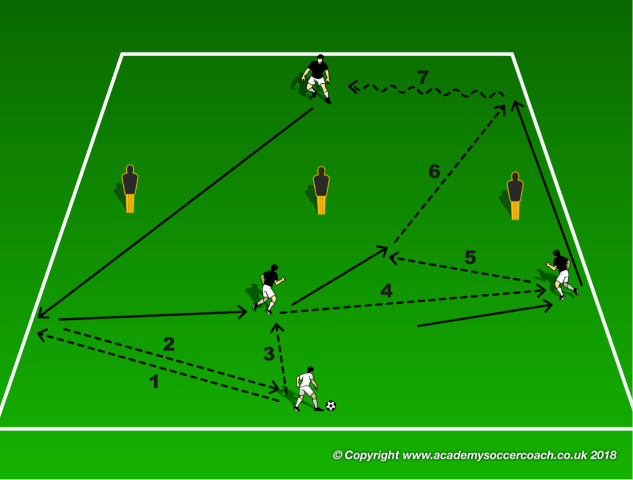
Set-up and Sequence: one goalkeeper and three players are placed inside a rectangular or square area; three air-bodies are placed in the middle to simulate three forwards on the same line. The goalkeeper is in possession and when he sends a sign, the center backs shift across the right (or on the left); the sequence starts from the left in the picture. The forward balance player must drop back, to cover the position of the left center back to play a wall passing combination with the goalkeeper. The goalkeeper than distributes again toward the opposite through the center backs, who play another wall passing combination to simulate the break through of the first pressure line, receiving the back pass behind the air-body. The sequence ends dribbling the ball toward the center space and passing back to the goalkeeper.
The players rotate their positions clockwise or counterclockwise.
Variation: the goalkeeper can indicate the side where to shift.
Eye on: play 1 touch passing combination to switch the side, drop back with the right timing, and work on different lines.


